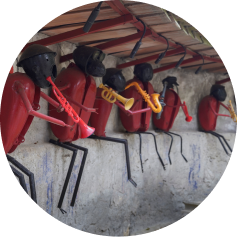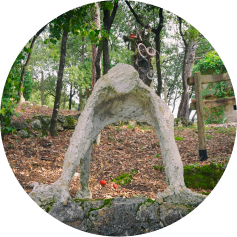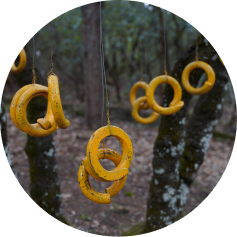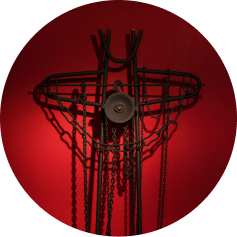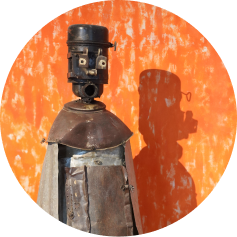
Untitled
Untitled
Brajo Fuso pays attention to the balance among different elements composing this artwork. As it is for other artists of the same period (such as Ettore Colla or Nino Franchina in Italy) or those artists of the Nouveau Réalisme in France, the aptitude of giving a new shape to scrap materials corresponds to the research of simple beauty, able to give dignity to something that in the past had a social utility.

Relegato
Relegato
Brajo Fuso has an inclination to play with both words and objects. The Relegato (Re-legato, which can be translated into wrapped king) refers to an imaginary monarch whose power is limited to a confined space. This statue is made of concrete and scrap materials. It is funny and worrying at the same time and the visitor is free to interpret its meaning.

Civetta (Owl)
Civetta (Owl)
Only a few materials are enough to build a sculpture. In this case, a part of a metal pipe and two knobs of gas tanks give birth to an owl observing the visitor with its shiny yellow eyes and a projecting beak. This sculpture, which is severe and intimidating but harmless at the same time, encourages the visitor to imagine the variety of creatures that can be found in a fantasy world.

Brancaleone, 1962
Brancaleone, 1962
The axle shaft of a little van and other scrap materials give birth to this bright-colours sculpture. Its name, Brancaleone, recalls the knight performed by Vittorio Gassman in the 1966 movie directed by Mario Monicelli. Brancaleone stands in front of the manor house to defend it, he is bold, brave and proud of himself, but in the end he is an ironic character, a bit clumsy, lucky but not capable. This artwork might represent a tribute to the Umbria region: in the movie, Brancaleone is from Norcia, a little town in Umbria, near the Sibillini Mountains.

Brajzoo
Brajzoo
For a long time, a large number of imaginary animals made of wrecked cars and other different materials were scattered all over the park of the Fuseum. Afterwards, Brajo Fuso decided to collect all these animals in an enclosed space near the amphitheatre that was called Brajzoo. The name is a combination of the word zoo and the author’s name, Brajo.

Bociarius
Bociarius
At the top of the park, there is a particular amphitheatre with an irregular shape where Brajo and Bettina used to organise little shows. After the restoration, it is possible to organise there concerts, plays and dance shows in order to pursue the idea of arts contamination that had the founders of this place.


